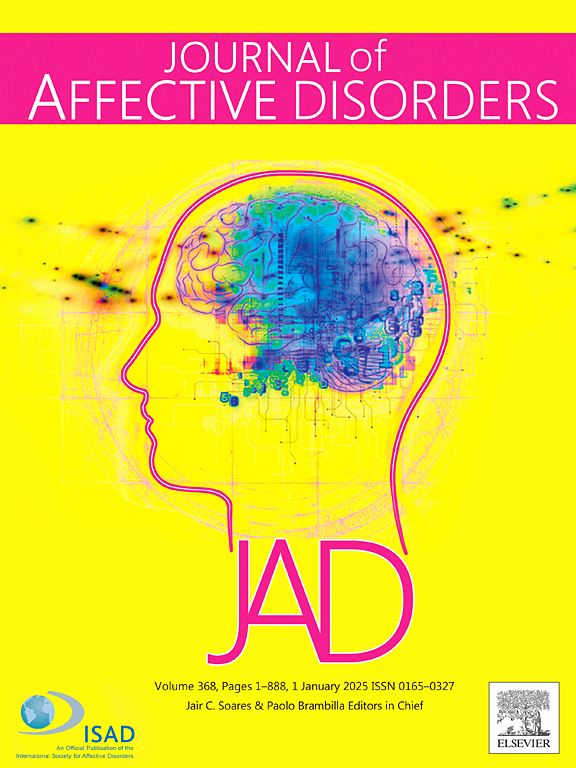运动阈值参数不能预测重复经颅磁刺激和间歇性θ波爆发刺激在重度抑郁症中的结果。
IF 4.9
2区 医学
Q1 CLINICAL NEUROLOGY
引用次数: 0
摘要
背景:重复经颅磁刺激(rTMS)和间歇θ波爆发刺激(iTBS)是治疗重度抑郁症(MDD)的无创治疗方法。虽然有效,但结果的可变性需要确定治疗反应的预测因素。本研究探讨了运动阈值(MT)、运动阈值百分比(%MT)和治疗强度是否可以预测接受rTMS和iTBS的MDD患者的临床结果。方法:纳入2016年2月至2024年4月在梅奥诊所接受神经之星rTMS或iTBS治疗的成年MDD患者。记录MT、MT %、处理强度。临床结果通过患者健康问卷-9 (PHQ-9)评分变化、缓解(PHQ-9变化≥50 %)、缓解(PHQ-9 )进行评估。结果:149例患者(平均年龄45.7岁,女性67.8% %),缓解率为43.0% %,缓解率为16.8% %。MT和MT百分比与临床结果无显著相关。治疗强度和经颅磁刺激类型不能预测PHQ-9评分的变化。较高的治疗强度与PRO阳性反应的几率降低相关。线性回归结果显示,年龄和性别对PHQ-9评分变化有显著预测作用,老年患者和女性患者改善更明显。与rTMS相比,男性和iTBS患者的MT明显较低。结论:MT、MT %和治疗强度不能可靠地预测预后。较高的强度与患者报告的帮助减少有关,这表明患者的舒适是至关重要的。iTBS较低的MT可能对那些需要较少刺激的患者有益。未来的研究应该确定更好的预测因子来改善经颅磁刺激的结果。本文章由计算机程序翻译,如有差异,请以英文原文为准。
Motor threshold parameters do not predict repetitive Transcranial Magnetic Stimulation and intermittent Theta Burst Stimulation outcomes in major depressive disorder
Background
Repetitive Transcranial Magnetic Stimulation (rTMS) and intermittent Theta Burst Stimulation (iTBS) are non-invasive treatments for major depressive disorder (MDD). While effective, variability in outcomes necessitates identifying predictors of therapeutic response. This study examined whether motor threshold (MT), percentage of motor threshold (%MT), and treatment intensity could predict clinical outcomes in MDD patients undergoing rTMS and iTBS.
Methods
Adult MDD patients treated with NeuroStar rTMS or iTBS at Mayo Clinic from February 2016 to April 2024 were included. MT, %MT, and treatment intensity were recorded. Clinical outcomes were assessed via Patient Health Questionnaire-9 (PHQ-9) score changes, response (PHQ-9 change ≥50 %), remission (PHQ-9 < 5), and a patient-reported outcome (PRO) on treatment helpfulness. Linear and logistic regression models were used to assess predictors of clinical outcomes.
Results
Among 149 patients analyzed (mean age 45.7, 67.8 % female), response rate was 43.0 % and remission rate was 16.8 %. MT and %MT did not significantly correlate with clinical outcomes. Treatment intensity and TMS type did not predict PHQ-9 score changes. Higher treatment intensity was associated with decreased odds of positive PRO responses. Linear regression showed that age and gender significantly predicted PHQ-9 score changes, with older patients and females showing greater improvement. MT was significantly lower in men and with iTBS compared to rTMS.
Conclusion
MT, %MT, and treatment intensity did not reliably predict outcomes. Higher intensity was linked to reduced patient-reported helpfulness, suggesting that patient comfort is crucial. iTBS's lower MT may benefit those needing less stimulation. Future research should identify better predictors to improve TMS outcomes.
求助全文
通过发布文献求助,成功后即可免费获取论文全文。
去求助
来源期刊

Journal of affective disorders
医学-精神病学
CiteScore
10.90
自引率
6.10%
发文量
1319
审稿时长
9.3 weeks
期刊介绍:
The Journal of Affective Disorders publishes papers concerned with affective disorders in the widest sense: depression, mania, mood spectrum, emotions and personality, anxiety and stress. It is interdisciplinary and aims to bring together different approaches for a diverse readership. Top quality papers will be accepted dealing with any aspect of affective disorders, including neuroimaging, cognitive neurosciences, genetics, molecular biology, experimental and clinical neurosciences, pharmacology, neuroimmunoendocrinology, intervention and treatment trials.
 求助内容:
求助内容: 应助结果提醒方式:
应助结果提醒方式:


